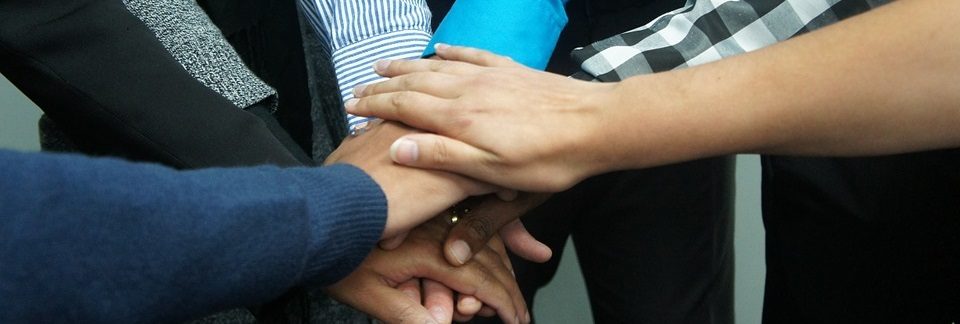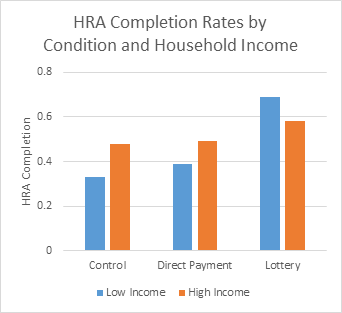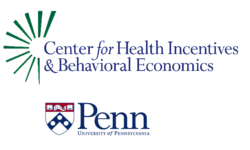
Workplace Wellness: Lottery Better than Cash
Organization : Center for Health Incentives and Behavioral Economics
Project Overview
Project Summary
In addition to a pre-existing incentive of $25 for completing a Health Risk Assessment (HRA), employees were either enrolled in a group-based lottery that rewarded all members of one randomly chosen team who had completed their HRA, or received a $25 grocery gift certificate for completing their HRA.
Impact
Enrolling groups in a team-based lottery led more employees to complete a Health Risk Assessment (64%) compared to offering an equal-value grocery gift certificate (44%) or offering a simple cash incentive in the comparison group (40%). This increase in the lottery group was especially strong for lower-income employees.
Cost
The lottery-based incentive was designed to cost the same for the implementing organization as the pre-existing incentive, while producing better results. Informing employees of the lottery program through e-mails means there are essentially no additional costs to the program beyond the lottery payouts.
Challenge
A critical first step in many corporate wellness programs is for employees to complete Health Risk Assessments (HRAs). However, getting employees to fill out HRAs and participate in these programs has been challenging. Around half of all wellness programs use financial incentives to encourage participation. Since different designs or structures of incentives can have different effects on behavior, it is important to assess which incentives are most effective so that the program is as effective as possible.
Design
Employees at a health care management company were assigned to one of three conditions:
- Lottery incentive: the researchers placed employees who had an existing account on the company’s health insurance website (or set one up within two days of receiving the e-mail) into teams of 4-8 employees. The employees received an e-mail explaining that in addition to a pre-existing $25 incentive for HRA completion, they would be eligible to participate in a lottery to win up to $125 more. The e-mail also contained the names of their team members. Each week, one team was selected as a winner, and each member of the winning team who had completed an HRA received $100, plus an additional $25 if at least 80% of the team had completed HRAs.
- Grocery gift certificate incentive: employees received an e-mail that introduced the pre-existing $25 incentive, and promised to reward them with an additional $25 grocery store gift certificate for completing their HRAs.
- Comparison: employees received an e-mail introducing the pre-existing $25 incentive for completing their HRAs.
The comparison sample was a convenience sample made up of employees whose managers were unwilling to implement interventions, while other employees were randomly assigned by office to one of the two treatment conditions. All participants received weekly e-mail reminders consistent with their conditions for a period of four weeks.
Impact
 In a randomized controlled trial, lottery-based incentives were more effective at motivating employees to complete their Health Risk Assessment (HRA) than an equal-value grocery gift certificate or simple cash incentive. Completion rates in the lottery condition (64%) were significantly higher than those in both the grocery gift certificate (44%) and comparison conditions (40%). This increase provided by the lottery incentive was especially strong for lower-income employees.
In a randomized controlled trial, lottery-based incentives were more effective at motivating employees to complete their Health Risk Assessment (HRA) than an equal-value grocery gift certificate or simple cash incentive. Completion rates in the lottery condition (64%) were significantly higher than those in both the grocery gift certificate (44%) and comparison conditions (40%). This increase provided by the lottery incentive was especially strong for lower-income employees.
The effect of the lottery incentive, however, may be underestimated because 22% of employees in that condition never established an account on the health insurance website and were therefore never assigned to a team. Of the participants in the lottery condition who were eligible to participate and assigned to a team, the HRA completion rate was 76%.
Implementation Guidelines
Inspired to implement this design in your own work? Here are some things to think about before you get started:
- Are the behavioral drivers to the problem you are trying to solve similar to the ones described in the challenge section of this project?
- Is it feasible to adapt the design to address your problem?
- Could there be structural barriers at play that might keep the design from having the desired effect?
- Finally, we encourage you to make sure you monitor, test and take steps to iterate on designs often when either adapting them to a new context or scaling up to make sure they’re effective.
Additionally, consider the following insights from the design’s researcher:
- Emphasize the possibility of feeling regret if someone’s team is selected to win, but they hadn’t yet filled out the HRA (or completed whatever step is required to be eligible to win).
- Highlight the bonus reward for having enough team members complete the HRA so people feel pressure to not let their fellow team members down.
- Using a lottery-based incentive may be particularly effective for lower-income employees.
- Variations in the exact lottery design may have similar or better effects in different contexts, as long as the essential elements (harnessing regret and social pressure) are preserved. For example, the team size or threshold for being eligible for the bonus can be adjusted to fit the organization size or culture.
- If possible, avoid barriers to eligibility such as having to register on the health insurance website.
- Lottery-based incentives may be similarly effective for other one-off health behaviors, such as getting a flu shot or getting a preventative screening.
For more guidance on implementing this design, select “I want to try this” from the left drop-down menu.
Project Credits
Researchers:
Emily Haisley Barclay's Wealth
Kevin Volpp University of Pennsylvania
Thomas Pellathy McKinsey and Co.
George Lowenstein Contact Carnegie Mellon University


